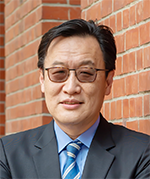用于临床前研究的超声:“小动物以及三维细胞培养系统的剪切波成像和光声成像”
日期:2023/09/26 – 2023/09/26
学术讲座:用于临床前研究的超声:“小动物以及三维细胞培养系统的剪切波成像和光声成像”
主讲人:Prof. Pai-Chi Li, TBF Chair in Biotechnology, Department of Electrical Engineering, Taiwan University
时间:2023年9月26日(周二)上午9:00
地点: 龙宾楼中集报告厅
讲座摘要
Ultrasound has been widely used for preclinical research on small animals. Another emerging area of preclinical research is based on the use of 3D cell culture systems. To fully exploit the value of preclinical research on small animals and 3D cell culture systems, new imaging and therapeutic technologies are needed. To this end, recent works on preclinical ultrasound in two particular areas will be covered in this lecture: acoustics based theranostic technologies and shear wave elasticity imaging. The acoustics based theranostic technologies are regarding the combination of ultrasound and photoacoustic/photothermal effects for synergistic delivery of gold nanoparticles using multifunctional microbubbles/nanodroplets for enhanced plasmonic photothermal therapy. In the second part of the lecture, we will present the applications of shear wave elasticity imaging to both small animals and 3D cell culture systems. In both cases, conventional shear wave imaging methods do not provide adequate accuracy and resolution, thus new approaches are needed. 3D cell culture systems have been used as an effective tool for preclinical research as they represent a more realistic model for cells compared to conventional 2D systems. Specifically, spatial dynamics of extracellular matrix provides a wealth of information concerning the collective activities and intercellular crosstalk of adhering cells. Shear wave elasticity imaging methods have been developed for 3D cell culture systems and research progress will be presented in this lecture. Finally, we will describe latest results on a microfluidic platform for a 3D microtumor culture system, as well as how photoacoustic molecular imaging and shear wave elasticity imaging can be applied to study mechanobiology on this platform. It will be clear to the audience that the role of ultrasound in preclinical research is significant and indispensible.
主讲人简介
 Pai-Chi Li received a B.S. degree in electrical engineering from Taiwan University in 1987 and an M.S. and Ph.D. degrees from the University of Michigan, Ann Arbor, in 1990 and 1994, respectively, both in electrical engineering: systems. He joined Acuson Corporation, Mountain View, CA, as a member of the Technical Staff in June 1994. His work in Acuson was primarily in medical ultrasonic imaging system design for cardiology and general imaging applications. In August 1997, he returned to the Department of Electrical Engineering at Taiwan University, where he is currently a Distinguished Professor of the Department of Electrical Engineering and Institute of Biomedical Electronics and Bioinformatics. He is also the TBF Chair in Biotechnology. He served as Founding Director of the Institute of Biomedical Electronics and Bioinformatics from 2006-2009 and Founding Director of Yong-Lin Biomedical Engineering Center from 2009-2011. He was also the Associate Dean of the College of Electrical Engineering and Computer Science from 2015-2018 and the Vice President for Research and Development of Taiwan University from 2019-2023. His current research interests include biomedical ultrasound and medical devices. Dr. Li is IEEE Fellow, IAMBE Fellow, AIUM Fellow, and SPIE Fellow. He was also Editor-in-Chief of the Journal of Medical and Biological Engineering and is the Deputy Editor-in-Chief Editor of Ultrasound in Medicine and Biology, Associate Editor of IEEE Transactions on Ultrasonics, Ferroelectrics, and Frequency Control, and on the Editorial Board of Ultrasonic Imaging and Photoacoustics. He has won numerous awards including Distinguished Research Award, the Dr. Wu Dayou Research Award and Distinguished Industrial Collaboration Award.
Pai-Chi Li received a B.S. degree in electrical engineering from Taiwan University in 1987 and an M.S. and Ph.D. degrees from the University of Michigan, Ann Arbor, in 1990 and 1994, respectively, both in electrical engineering: systems. He joined Acuson Corporation, Mountain View, CA, as a member of the Technical Staff in June 1994. His work in Acuson was primarily in medical ultrasonic imaging system design for cardiology and general imaging applications. In August 1997, he returned to the Department of Electrical Engineering at Taiwan University, where he is currently a Distinguished Professor of the Department of Electrical Engineering and Institute of Biomedical Electronics and Bioinformatics. He is also the TBF Chair in Biotechnology. He served as Founding Director of the Institute of Biomedical Electronics and Bioinformatics from 2006-2009 and Founding Director of Yong-Lin Biomedical Engineering Center from 2009-2011. He was also the Associate Dean of the College of Electrical Engineering and Computer Science from 2015-2018 and the Vice President for Research and Development of Taiwan University from 2019-2023. His current research interests include biomedical ultrasound and medical devices. Dr. Li is IEEE Fellow, IAMBE Fellow, AIUM Fellow, and SPIE Fellow. He was also Editor-in-Chief of the Journal of Medical and Biological Engineering and is the Deputy Editor-in-Chief Editor of Ultrasound in Medicine and Biology, Associate Editor of IEEE Transactions on Ultrasonics, Ferroelectrics, and Frequency Control, and on the Editorial Board of Ultrasonic Imaging and Photoacoustics. He has won numerous awards including Distinguished Research Award, the Dr. Wu Dayou Research Award and Distinguished Industrial Collaboration Award.
